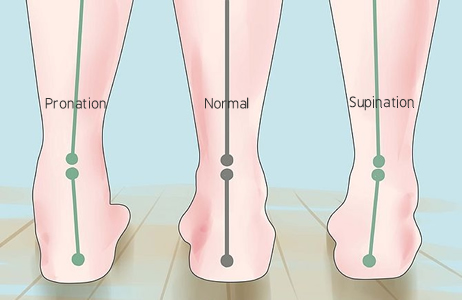There’s something you need to know before you run out to buy a new pair of kicks for your strength training workout. You need to know your foot type.
By that I mean, do you have a neutral foot, flat foot, or a high arch?
Because each will have very different requirements when it comes to the type of training shoe you should wear.
These three categories describe the position of your subtalar joint (STJ) while standing.
This joint is located in the back part of your foot and has a major influence on how your body uses ground reaction forces from each step you take. And depending on its position, it’s either supporting or hindering functional movement.
How to determine your foot type
All you need is a camera and someone to snap a photo of your barefoot from behind. Place the camera perpendicular on the ground so it’s level and vertical.
Stand with your feet hip distance apart and the heels in a straight line behind the toes and take your photo.
Then, examine each foot’s heel cord (Achilles tendon). This is the vertical connective tissue that leads from your heel (calcaneus) into your lower leg.
Neutral Foot
Your heel cord forms a straight, vertical line. And there are no concave indents visible on either side of your heel.
A neutral foot means that your STJ starts in a centered position… the “sweet spot”. This allows your body to best load and unload ground reaction forces and gravity. So you can harness this free energy into into elastic power to move in any direction.
And all athletes with neutral feet should cherish this, because it allows you to have that spring in your step…and bounce in your hop. It also gives you the capability to better accelerate and decelerate.
If you’re missing that spring in your step, it may be more likely that you have one of the other two types.
Flat Foot
Your heel cord is curving towards the inside of your ankle (medial). And there’s a small indent on the medial side of your heel.
A flat foot means that your foot is more prone to eversion. That means that the arch in your foot is likely to collapse, putting more weight on the medial side of the foot when applying load.
The instability of this foot position feeds further instability up the chain. It leads to less power and a host of potential injuries.
High Arch
Your heel cord curves towards the outside of your ankle (lateral). And there’s a small indent on the outer aspect of the heel.
Having a high arch means that you tend to put more weight on the outside of your foot (inversion). This creates a rigidity in the STJ.
So the ground reaction forces get trapped in the body instead of released into your movement. Again, the result is a limit in your power and a risk increase in impact-related injuries.
The right shoe for your foot type
If you have a flat foot or a high arch, you’ll want to find a shoe that helps you start in a neutral foot position.
If you’re fortunate enough to have both feet in neutral, then you have more options to choose from. My previous message has some suggestions.
If you have a high arch or a neutral foot, then a transition shoe with slight heel-to-toe drop would be better.
Two examples are the Inov-8 195 F2 and Reebok Crossfit Nano 7.
It’s important to keep in mind that no matter which foot type you have, the right shoe is only part of the equation.
You also need to have a proactive program to improve the strength and mobility of your feet. And add in a good recovery plan using myofascial rolling techniques to keep the tissues healthy.
Now that you have this knowledge, you can take action so that you have peace of mind that you have the right support from your shoe.
For more tips like this, subscribe to my YouTube channel here.
Until next time, stay athletic.
Your coach,
Adam
Image: HealthyStep

